Abstract
1. Normal subjects, with closed eyes, attempted to keep constant either the force exerted at the wrist or the position of the wrist against an elastic load. The load was attached to the wrist 275 mm from the axis of rotation of the elbow joint. During recording, the far end of the elastic load was displaced slowly enough that it was not immediately perceived but far enough for perception to occur before its completion. 2. The over-all relation between wrist force and position for the two conditions was approximately linear and could be described in terms of effective stiffness. The effective stiffness for the constant-position task averaged 2.8 N/mm (210 N m/rad), while for the constant-force task the mean effective stiffness was -0.028 N/mm (-2.1 N m/rad), indicative of slight over-compensation. 3. Averaging the performance at the onset of the imposed disturbance indicated that the subjects' behaviour consisted of two parts: an initial, small-range response followed by a second phase over the remainder of the displacement. The transition corresponded to the subjects' threshold for detection of the disturbance. 4. The stiffness measured for the response prior to perception was taken as a measure which included the tonic stretch reflex. The stiffness was altered appropriately for the two tasks, being lower when the subjects tried to maintain the force exerted constant (average 1.1 N/mm, 83 N m/rad) than when they attempted to keep the position constant (average 2.3 N/mm, 170 N m/rad). A small degree of co-contraction occurred but could be dissociated from the stiffness changes. 5. Scaling the results allowed comparison of the initial stiffness with values for the decerebrate cat. When analysed in this way, the values recorded in man during the constant-position task were similar to those reported for short-range stiffness in the decerebrate cat. 6. The thresholds for detection of the disturbance were much lower than those reported for subjects with relaxed muscles. 7. The stretch reflex in man has a direct role in compensating for small disturbances during motor tasks. It may also function to improve detection of applied disturbances by magnifying the corresponding force change. Once the stimulus is perceived and voluntary intervention is possible, a greater contrast is seen between the subjects' performance of the two tasks.
Full text
PDF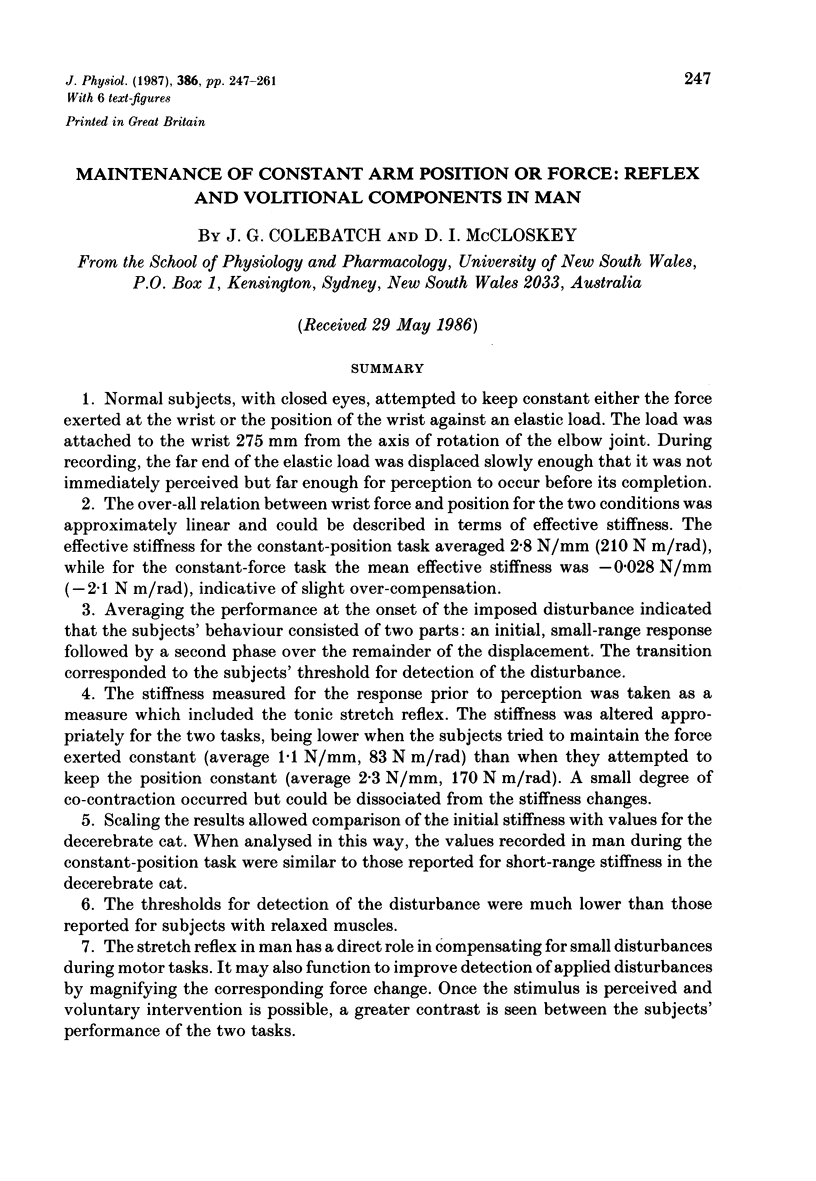
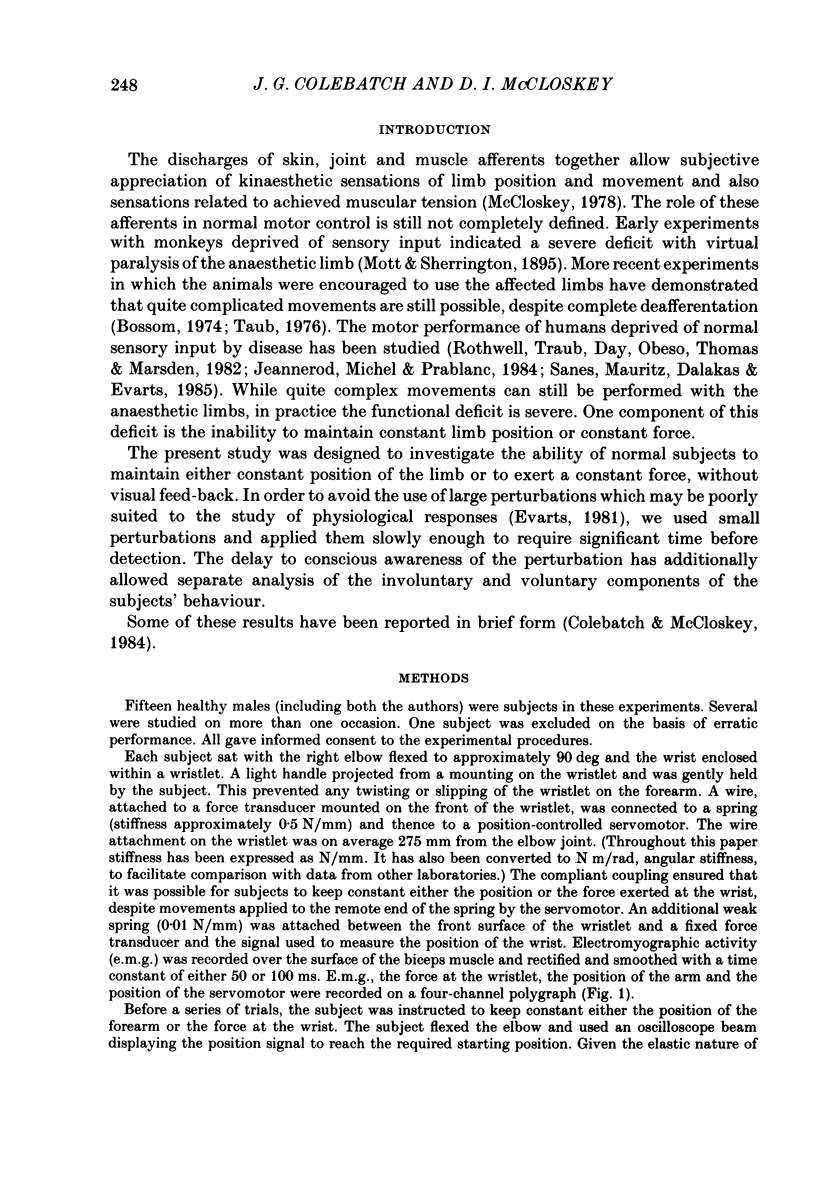
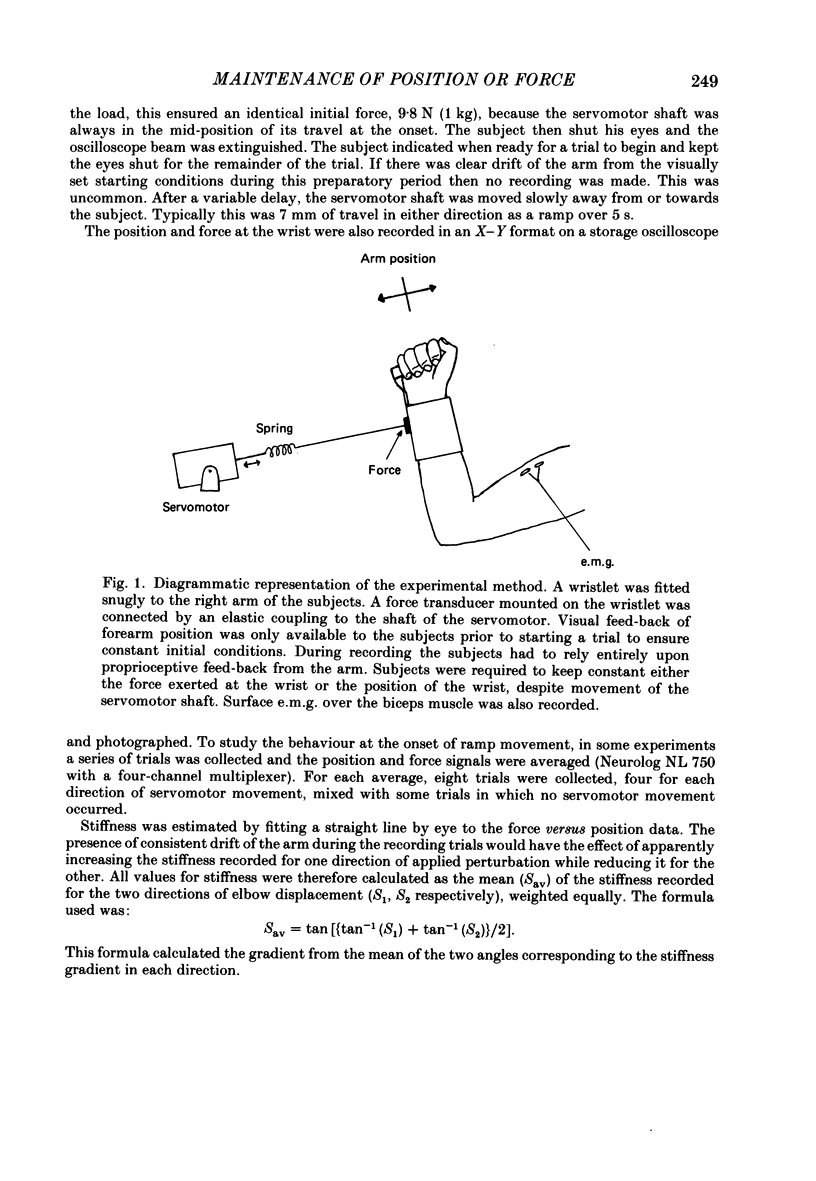
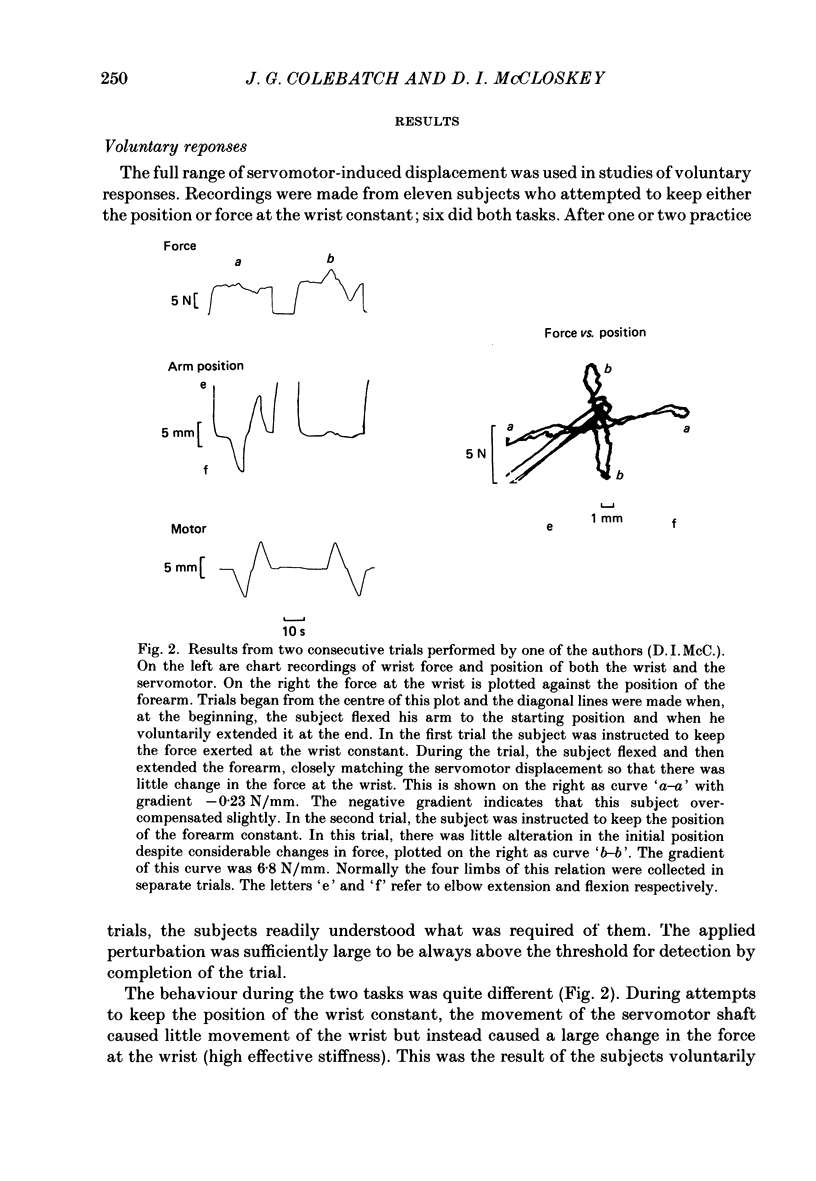
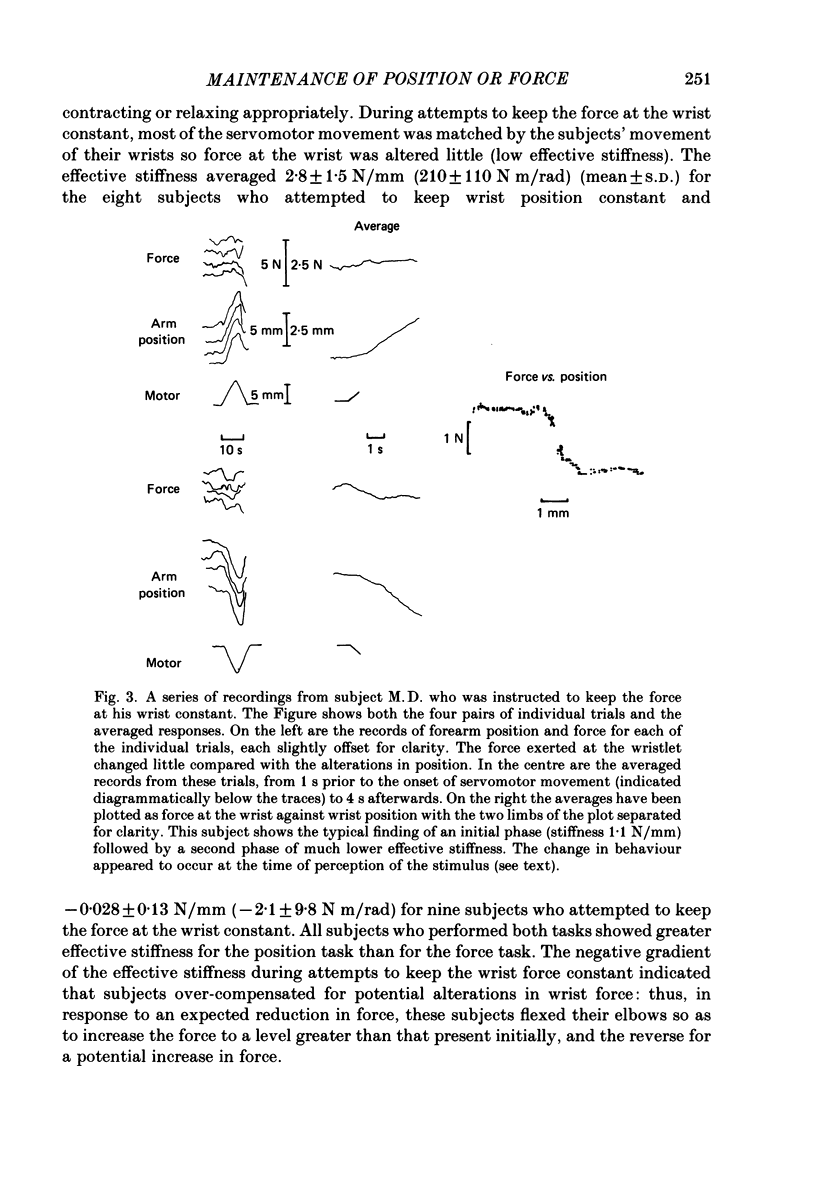

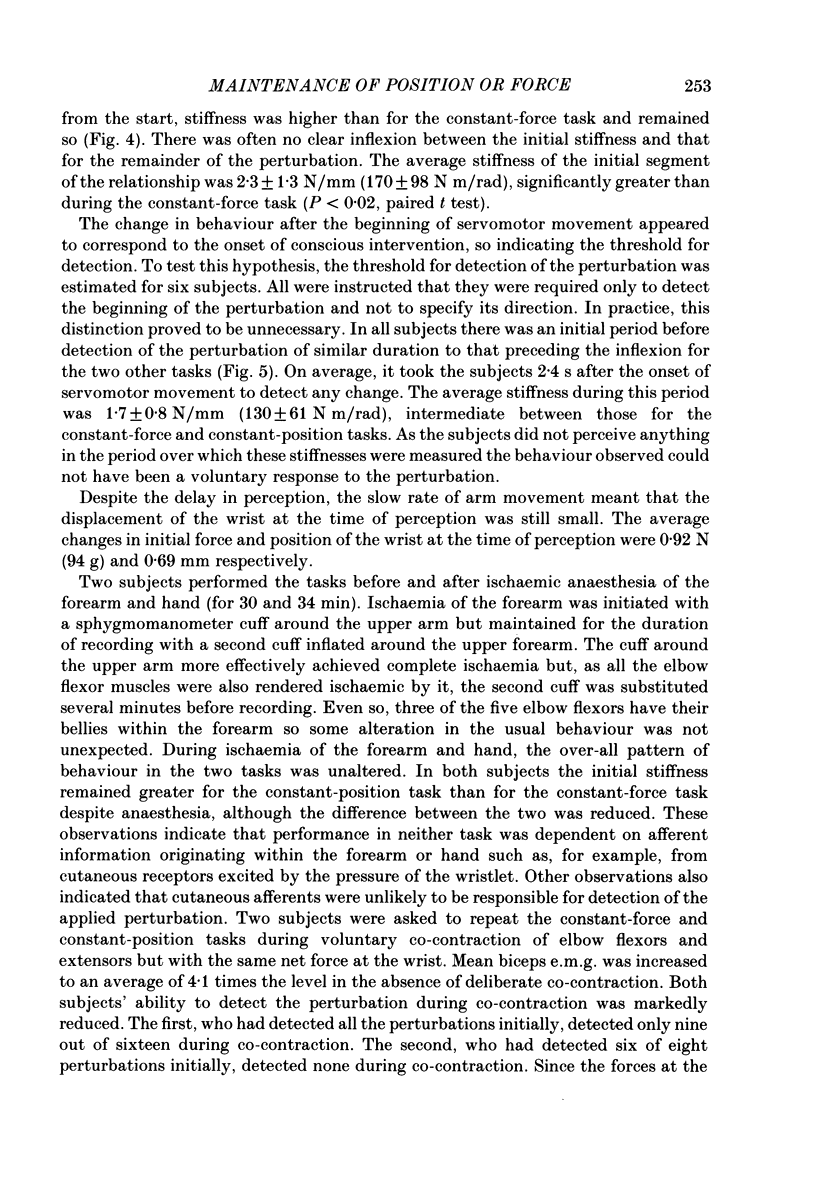
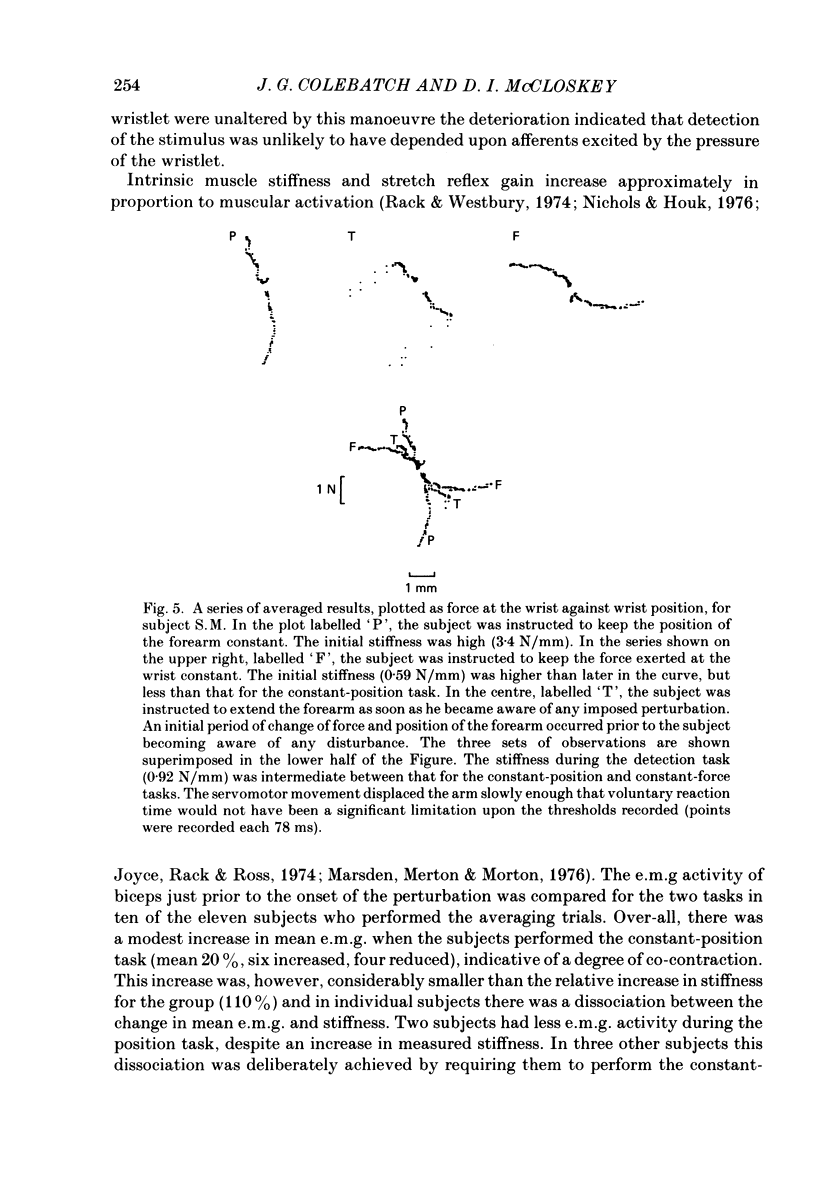
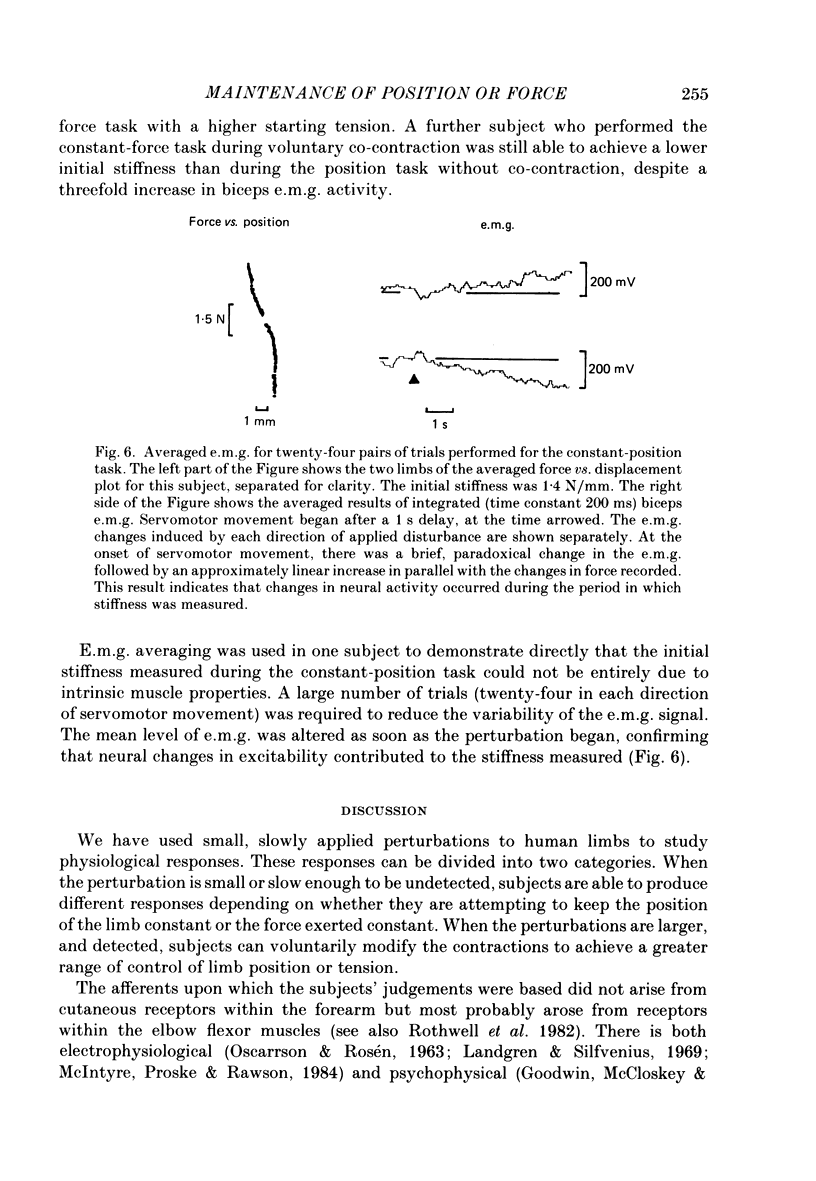
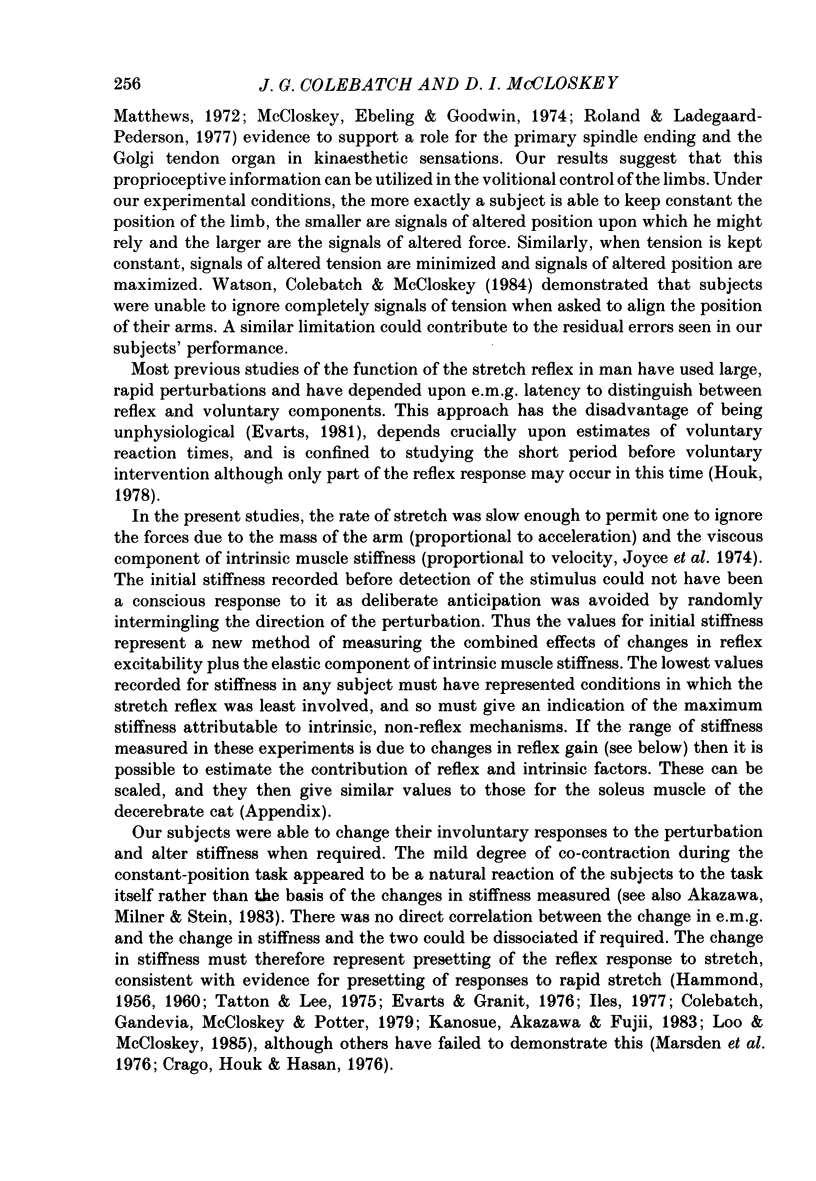
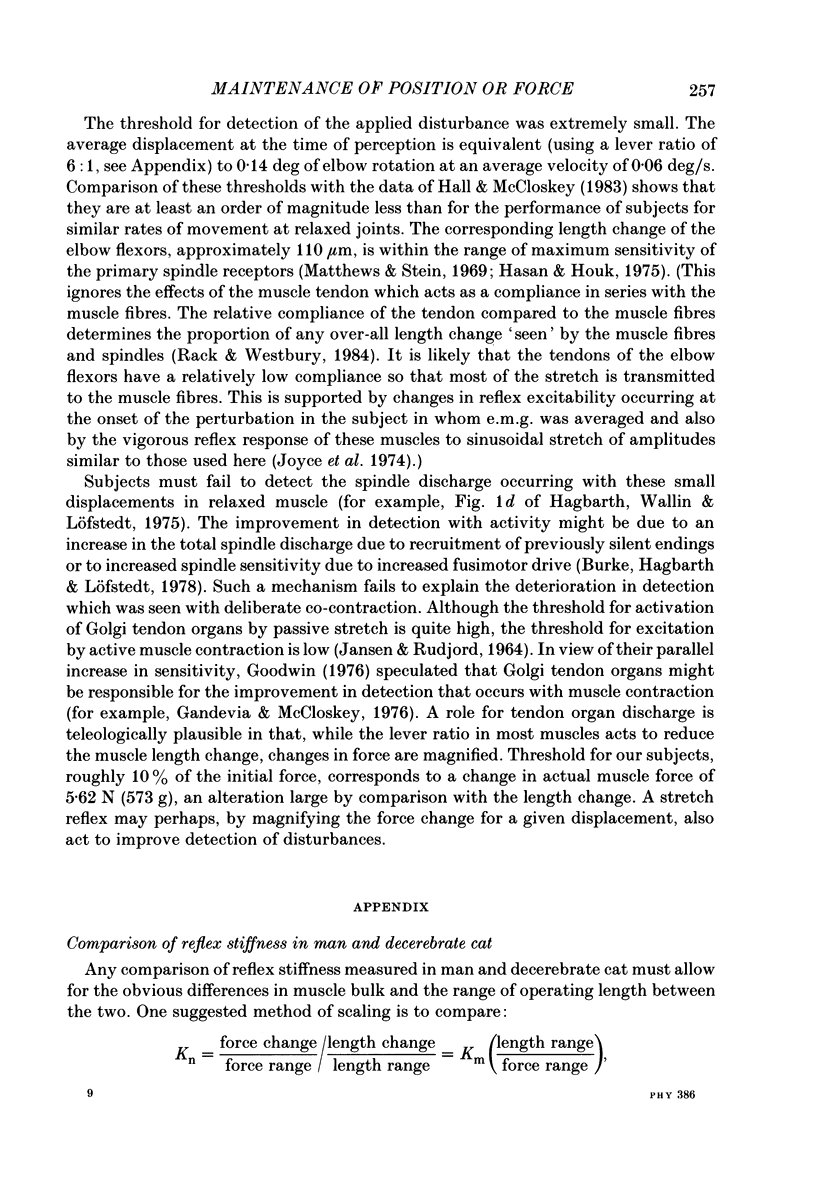
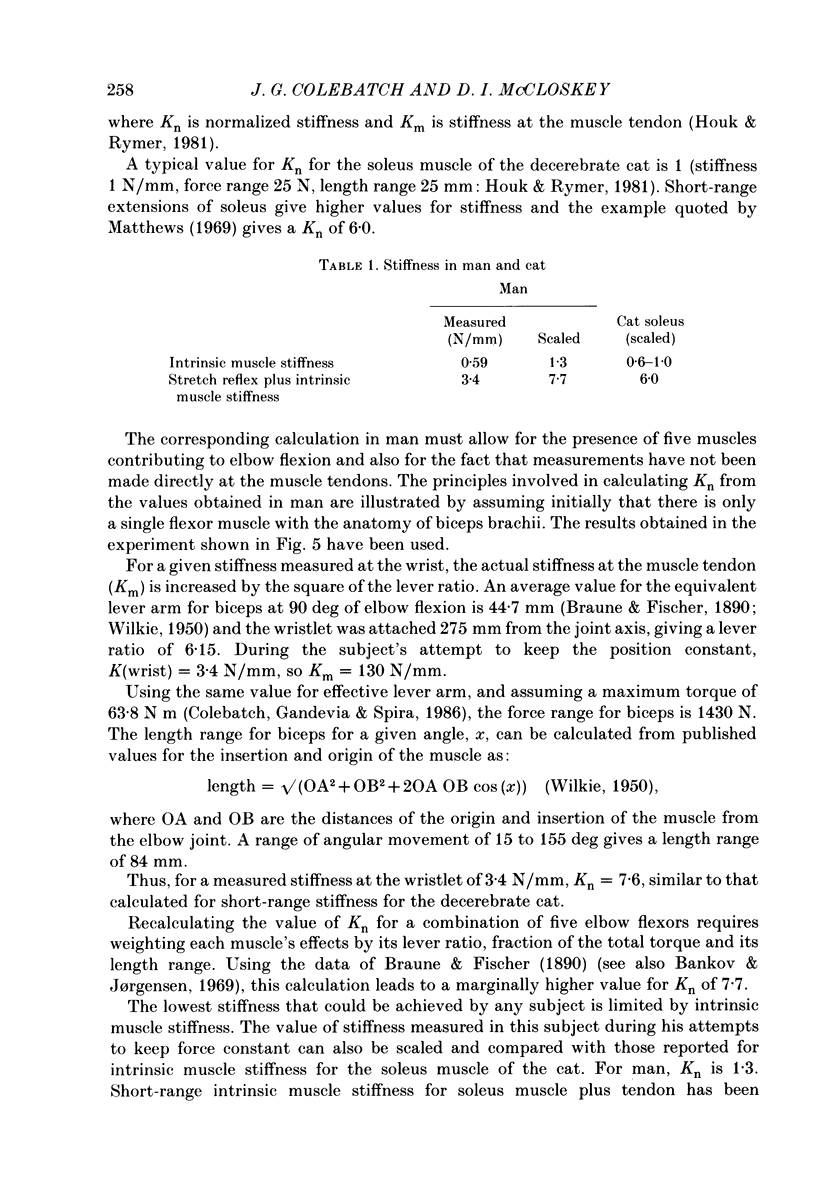

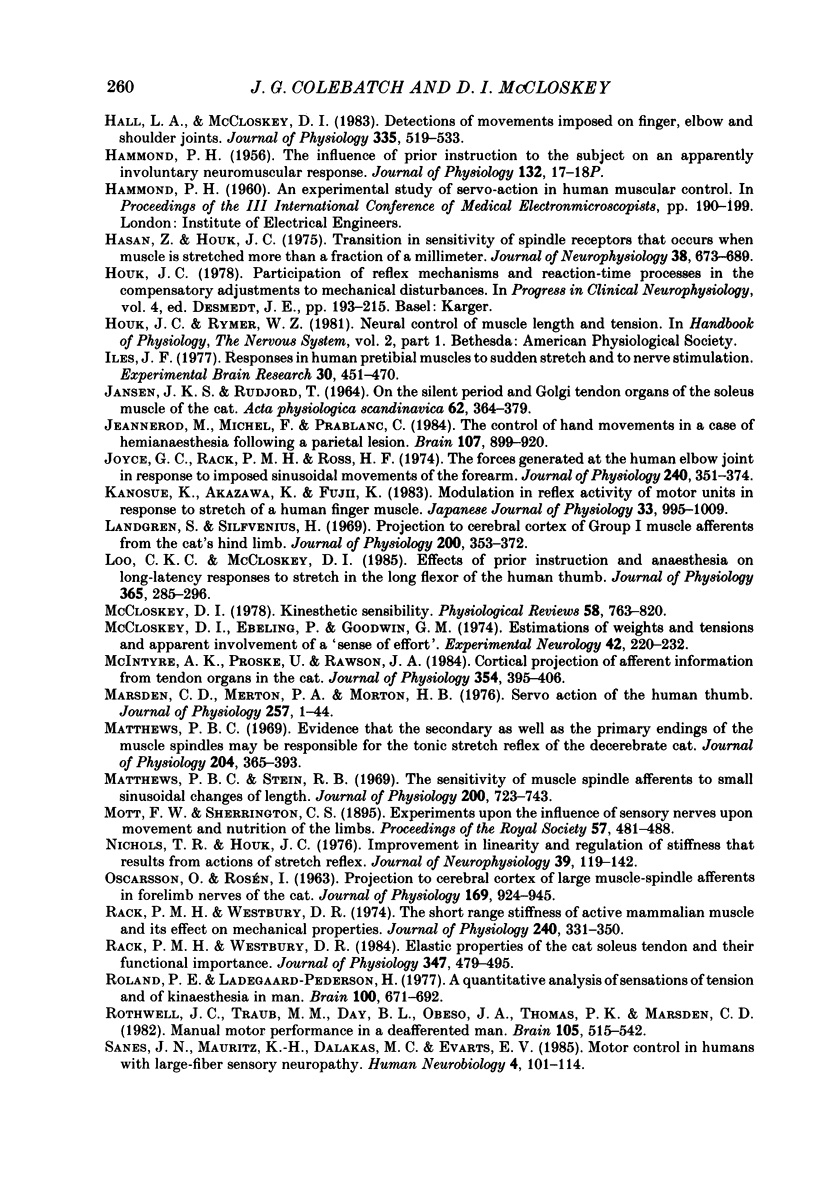
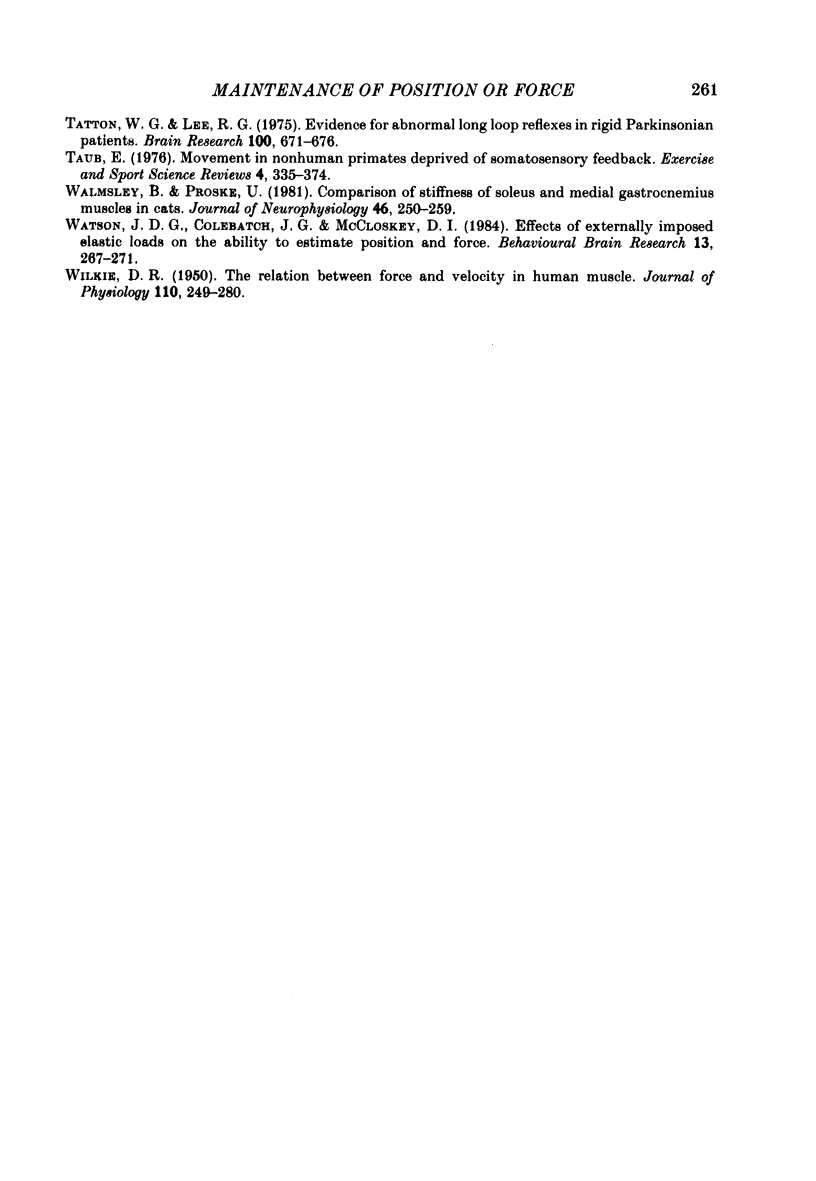
Selected References
These references are in PubMed. This may not be the complete list of references from this article.
- Akazawa K., Milner T. E., Stein R. B. Modulation of reflex EMG and stiffness in response to stretch of human finger muscle. J Neurophysiol. 1983 Jan;49(1):16–27. doi: 10.1152/jn.1983.49.1.16. [DOI] [PubMed] [Google Scholar]
- Burke D., Hagbarth K. E., Löfstedt L. Muscle spindle responses in man to changes in load during accurate position maintenance. J Physiol. 1978 Mar;276:159–164. doi: 10.1113/jphysiol.1978.sp012225. [DOI] [PMC free article] [PubMed] [Google Scholar]
- Colebatch J. G., Gandevia S. C., McCloskey D. I., Potter E. K. Subject instruction and long latency reflex responses to muscle stretch. J Physiol. 1979 Jul;292:527–534. doi: 10.1113/jphysiol.1979.sp012869. [DOI] [PMC free article] [PubMed] [Google Scholar]
- Colebatch J. G., Gandevia S. C., Spira P. J. Voluntary muscle strength in hemiparesis: distribution of weakness at the elbow. J Neurol Neurosurg Psychiatry. 1986 Sep;49(9):1019–1024. doi: 10.1136/jnnp.49.9.1019. [DOI] [PMC free article] [PubMed] [Google Scholar]
- Crago P. E., Houk J. C., Hasan Z. Regulatory actions of human stretch reflex. J Neurophysiol. 1976 Sep;39(5):925–935. doi: 10.1152/jn.1976.39.5.925. [DOI] [PubMed] [Google Scholar]
- Gandevia S. C., McCloskey D. I. Joint sense, muscle sense, and their combination as position sense, measured at the distal interphalangeal joint of the middle finger. J Physiol. 1976 Sep;260(2):387–407. doi: 10.1113/jphysiol.1976.sp011521. [DOI] [PMC free article] [PubMed] [Google Scholar]
- Goodwin G. M., McCloskey D. I., Matthews P. B. The contribution of muscle afferents to kinaesthesia shown by vibration induced illusions of movement and by the effects of paralysing joint afferents. Brain. 1972;95(4):705–748. doi: 10.1093/brain/95.4.705. [DOI] [PubMed] [Google Scholar]
- Goodwin G. M. The sense of limb position and movement. Exerc Sport Sci Rev. 1976;4:87–124. [PubMed] [Google Scholar]
- HAMMOND P. H. The influence of prior instruction to the subject on an apparently involuntary neuro-muscular response. J Physiol. 1956 Apr 27;132(1):17–8P. [PubMed] [Google Scholar]
- Hagbarth K. E., Wallen G., Löfstedt L. Muscle spindle activity in man during voluntary fast alternating movements. J Neurol Neurosurg Psychiatry. 1975 Jul;38(7):625–635. doi: 10.1136/jnnp.38.7.625. [DOI] [PMC free article] [PubMed] [Google Scholar]
- Hall L. A., McCloskey D. I. Detections of movements imposed on finger, elbow and shoulder joints. J Physiol. 1983 Feb;335:519–533. doi: 10.1113/jphysiol.1983.sp014548. [DOI] [PMC free article] [PubMed] [Google Scholar]
- Hasan Z., Houk J. C. Transition in sensitivity of spindle receptors that occurs when muscle is stretched more than a fraction of a millimeter. J Neurophysiol. 1975 May;38(3):673–689. doi: 10.1152/jn.1975.38.3.673. [DOI] [PubMed] [Google Scholar]
- Iles J. F. Responses in human pretibial muscles to sudden stretch and to nerve stimulation. Exp Brain Res. 1977 Dec 19;30(4):451–470. doi: 10.1007/BF00237637. [DOI] [PubMed] [Google Scholar]
- JANSEN J. K., RUDJORD T. ON THE SILENT PERIOD AND GOLGI TENDON ORGANS OF THE SOLEUS MUSCLE OF THE CAT. Acta Physiol Scand. 1964 Dec;62:364–379. doi: 10.1111/j.1748-1716.1964.tb10435.x. [DOI] [PubMed] [Google Scholar]
- Jeannerod M., Michel F., Prablanc C. The control of hand movements in a case of hemianaesthesia following a parietal lesion. Brain. 1984 Sep;107(Pt 3):899–920. doi: 10.1093/brain/107.3.899. [DOI] [PubMed] [Google Scholar]
- Joyce G. C., Rack P. M., Ross H. F. The forces generated at the human elbow joint in response to imposed sinusoidal movements of the forearm. J Physiol. 1974 Jul;240(2):351–374. doi: 10.1113/jphysiol.1974.sp010614. [DOI] [PMC free article] [PubMed] [Google Scholar]
- Kanosue K., Akazawa K., Fujii K. Modulation of reflex activity of motor units in response to stretch of a human finger muscle. Jpn J Physiol. 1983;33(6):995–1009. doi: 10.2170/jjphysiol.33.995. [DOI] [PubMed] [Google Scholar]
- Landgren S., Silfvenius H. Projection to cerebral cortex of group I muscle afferents from the cat's hind limb. J Physiol. 1969 Feb;200(2):353–372. doi: 10.1113/jphysiol.1969.sp008698. [DOI] [PMC free article] [PubMed] [Google Scholar]
- Loo C. K., McCloskey D. I. Effects of prior instruction and anaesthesia on long-latency responses to stretch in the long flexor of the human thumb. J Physiol. 1985 Aug;365:285–296. doi: 10.1113/jphysiol.1985.sp015772. [DOI] [PMC free article] [PubMed] [Google Scholar]
- Marsden C. D., Merton P. A., Morton H. B. Servo action in the human thumb. J Physiol. 1976 May;257(1):1–44. doi: 10.1113/jphysiol.1976.sp011354. [DOI] [PMC free article] [PubMed] [Google Scholar]
- Matthews P. B. Evidence that the secondary as well as the primary endings of the muscle spindles may be responsible for the tonic stretch reflex of the decerebrate cat. J Physiol. 1969 Oct;204(2):365–393. doi: 10.1113/jphysiol.1969.sp008918. [DOI] [PMC free article] [PubMed] [Google Scholar]
- Matthews P. B., Stein R. B. The sensitivity of muscle spindle afferents to small sinusoidal changes of length. J Physiol. 1969 Feb;200(3):723–743. doi: 10.1113/jphysiol.1969.sp008719. [DOI] [PMC free article] [PubMed] [Google Scholar]
- McCloskey D. I., Ebeling P., Goodwin G. M. Estimation of weights and tensions and apparent involvement of a "sense of effort". Exp Neurol. 1974 Jan;42(1):220–232. doi: 10.1016/0014-4886(74)90019-3. [DOI] [PubMed] [Google Scholar]
- McCloskey D. I. Kinesthetic sensibility. Physiol Rev. 1978 Oct;58(4):763–820. doi: 10.1152/physrev.1978.58.4.763. [DOI] [PubMed] [Google Scholar]
- McIntyre A. K., Proske U., Rawson J. A. Cortical projection of afferent information from tendon organs in the cat. J Physiol. 1984 Sep;354:395–406. doi: 10.1113/jphysiol.1984.sp015383. [DOI] [PMC free article] [PubMed] [Google Scholar]
- Nichols T. R., Houk J. C. Improvement in linearity and regulation of stiffness that results from actions of stretch reflex. J Neurophysiol. 1976 Jan;39(1):119–142. doi: 10.1152/jn.1976.39.1.119. [DOI] [PubMed] [Google Scholar]
- OSCARSSON O., ROSEN I. PROJECTION TO CEREBRAL CORTEX OF LARGE MUSCLE-SPINDLE AFFERENTS IN FORELIMB NERVES OF THE CAT. J Physiol. 1963 Dec;169:924–945. doi: 10.1113/jphysiol.1963.sp007305. [DOI] [PMC free article] [PubMed] [Google Scholar]
- Rack P. M., Westbury D. R. Elastic properties of the cat soleus tendon and their functional importance. J Physiol. 1984 Feb;347:479–495. doi: 10.1113/jphysiol.1984.sp015077. [DOI] [PMC free article] [PubMed] [Google Scholar]
- Rack P. M., Westbury D. R. The short range stiffness of active mammalian muscle and its effect on mechanical properties. J Physiol. 1974 Jul;240(2):331–350. doi: 10.1113/jphysiol.1974.sp010613. [DOI] [PMC free article] [PubMed] [Google Scholar]
- Roland P. E., Ladegaard-Pedersen H. A quantitative analysis of sensations of tension and of kinaesthesia in man. Evidence for a peripherally originating muscular sense and for a sense of effort. Brain. 1977 Dec;100(4):671–692. doi: 10.1093/brain/100.4.671. [DOI] [PubMed] [Google Scholar]
- Rothwell J. C., Traub M. M., Day B. L., Obeso J. A., Thomas P. K., Marsden C. D. Manual motor performance in a deafferented man. Brain. 1982 Sep;105(Pt 3):515–542. doi: 10.1093/brain/105.3.515. [DOI] [PubMed] [Google Scholar]
- Sanes J. N., Mauritz K. H., Dalakas M. C., Evarts E. V. Motor control in humans with large-fiber sensory neuropathy. Hum Neurobiol. 1985;4(2):101–114. [PubMed] [Google Scholar]
- Tatton W. G., Lee R. G. Evidence for abnormal long-loop reflexes in rigid Parkinsonian patients. Brain Res. 1975 Dec 26;100(3):671–676. doi: 10.1016/0006-8993(75)90167-5. [DOI] [PubMed] [Google Scholar]
- Taub E. Movement in nonhuman primates deprived of somatosensory feedback. Exerc Sport Sci Rev. 1976;4:335–374. [PubMed] [Google Scholar]
- WILKIE D. R. The relation between force and velocity in human muscle. J Physiol. 1949 Dec;110(3-4):249–280. doi: 10.1113/jphysiol.1949.sp004437. [DOI] [PMC free article] [PubMed] [Google Scholar]
- Walmsley B., Proske U. Comparison of stiffness of soleus and medial gastrocnemius muscles in cats. J Neurophysiol. 1981 Aug;46(2):250–259. doi: 10.1152/jn.1981.46.2.250. [DOI] [PubMed] [Google Scholar]
- Watson J. D., Colebatch J. G., McCloskey D. I. Effects of externally imposed elastic loads on the ability to estimate position and force. Behav Brain Res. 1984 Sep;13(3):267–271. doi: 10.1016/0166-4328(84)90169-4. [DOI] [PubMed] [Google Scholar]


